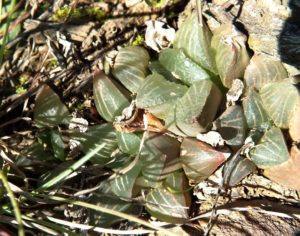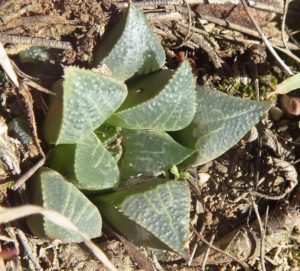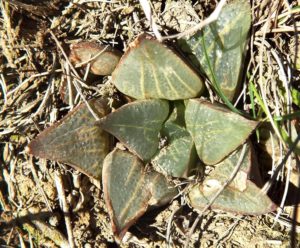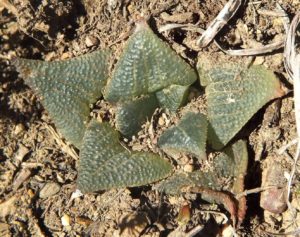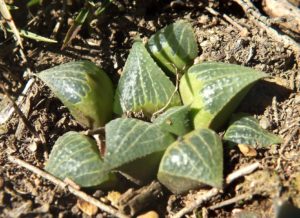16. 2019.5.20 – The following plants were in bud in July to indicate a September flowering. North of this location is a large area with a lot of mirabilis and only one lot of retusa and again the retusa does not share the same space as any mirabilis. I need to find a word for that as something like sympatric or co-occurring does not quite fit. Haworthia habitats are probably characterised by their mixed-upness :). Small scale fragmentation. I will add a picture here of a habitat that is a small narrow fringe of exposed shale – the place used to house floribunda until under intensive pasturage everything was grazed away. Across the river is an area where there was a retusoid that was in short shrubby vegetation now being encroached by taller bush. It is nothing like it was 40 years before. Changes like this can be seen in the span of human life but it is still very difficult to assess just how much does change. The missing word seems to be contiguous – the populations may come so close as to have a common border but not randomly mixing. Otherwise populations may be in close proximity. There are many such inexplicable complexities that we gloss over in trying to understand nature. This mystery I am trying to explain is not going to be resolved in the next post or several thereafter – it will take all the pictures. By which time we will have forgotten where we started?
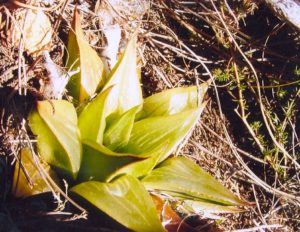
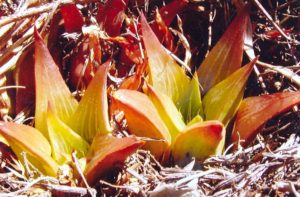

17. 2019.5.20 – This is from populations still further north and northwest of Heidelberg taken from before the days of digital camera – sadly. Mirabiloids seem to be absent and so is floribunda. But this is missing from the whole argument and tack … it seems I have not stated, or not states strongly enough, that Haworthia retusa is a single species incorporating the main elements H. turgida, H. mirabilis, H. mutica, H. pygmaea and H. emelyae. I am forced to include H. floribunda although that then leads on to many more seemingly improbable connections. What we have is a single gene pool represented by a large series of populations broken up on the basis of geographic space, local geology, aspect, slope and altitude. A major driver is two flowering periods among the populations; one is early spring and the other late summer early autumn. A significant point is that each population is discrete and seldom indeed can we identify a freely mixing population of two different species. While a whole additional set of names may be needed for the enthusiast and collector, it does not actually make sense to generate Latin binomials that just touch on some of the variability seen within populations and between. Five names is quite enough for practical purposes while for a collector or grower many more are useful. For a strictly botanical record one may be a true reflection of the state?

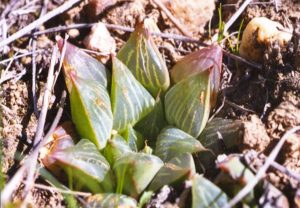
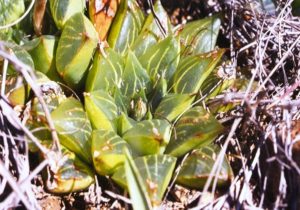
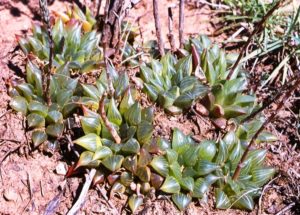
18. 2019.5.21 – From immediately south of Tradouw Pass. This population puzzled me for years. Inside the pass itself in 1970, were cliffs clothed with turgida retusa. Then the road was re-cut and the cliff faces destroyed. Westwards was the road to Zuurbraak with steep riverine vegetation. These cliffs were shale and could have held many mysteries. They were cut away too. I am not sure thus just where H. mirabilis may have been in the vicinity but these plants are practically certainly a consequence of a hybridization between the mirabiloids and the retusoids. These pictures were taken in March when the plants were flowering. Retusa’s flower in the spring.
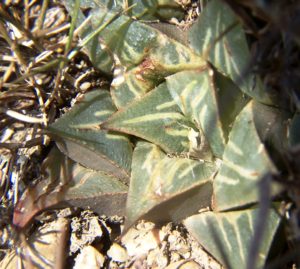
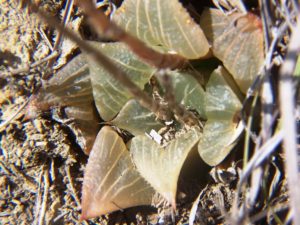

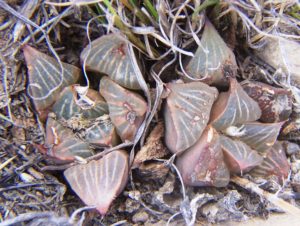
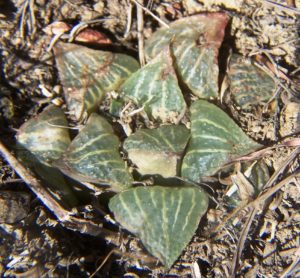
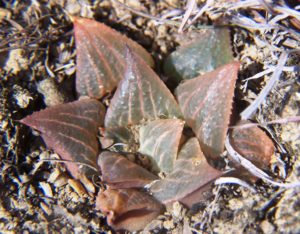



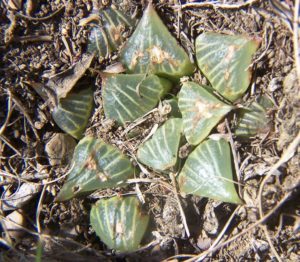
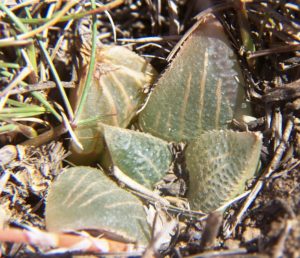
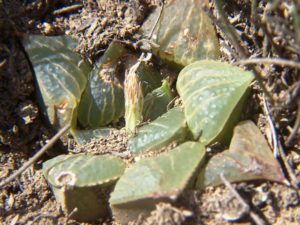
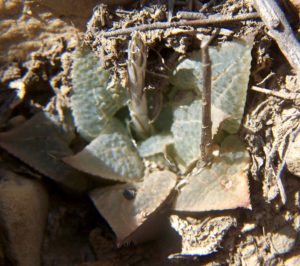
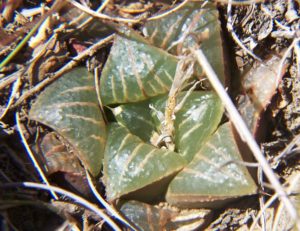
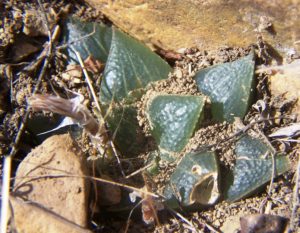
Jaap Viljoen: Bruce what would you call them? Due to farming activities there are not many left.
Bruce Bayer: Jaap – I am sure someone has coined a name for this all ready? AND I cannot deny it is very difficult to answer the question. Botany does not provide for this. I could say H. mirabilisXretusa, or H. retusa Tradouw. My suggestion would be that the Haworthia community through one of the Societies (where Aloe, Haworthiad and others have been very tardy in supporting any suggestion of such an idea) just concede that the formal botanical Latin systems does not serve common interest, and establish a secondary naming system. Use that existing coined name but dot not fool anyone into thinking it means anything more than a collector item. As I recently posted – it is just not sensible to use a formal Latin botanical name because most of the plant forms found in this population can be seen in many other populations across the whole southern Cape from Caledon to Great Brak – and north of the Langeberg. We can’t live with our head in the sand about this issue forever?
Jaap’s question about a name for these things is important and just what this group about. For the collector, the name is connected to what the plant LOOKS like. To the botanist it is where the plant is in the history and evolutionary pathway, what its DNA is or tells them and perhaps a lot more depending on some discipline or other in the subject. This is another set of pictures from S Tradouw – same place as previous but taken in September. I have another set of 34 pictures of seed grown plants and no two plants look the same. Perhaps members can explain to me what single name is going to serve a meaningful purpose. Nearly every single population presents this problem. What riles me about the DNA sequencing I have been involved in is that single specimens are taken to represent “species” in a sequencing project based on an existing classification. Perhaps someone has done a study where sequencing has been done on a raw set of unnamed specimens replicated from one population as well as representing populations across the gamut of the group in question? I have yet to learn of it.
A very pertinent question by my friend Jaap – what do we call plants from south of Tradouw – when no two plants are the same? It raises the question of the definition of the species and the establishment of identity. In the present informal systems where commercial growers and also the very highly skilled observers like M. Hayashi have great expertise, there will be a name – but that name will not fit all the variants in the population nor the endless number of variants that will emerge among seed grown plants. In the present formal system it should be H. mirabilisXretusa and the locality name should be added, as there are other such hybrids (single or in populations). In a system based on a more rational definition than is currently used, I think it should simply be H. retusa!
Jaap Viljoen: As I expressed my views before about all the discussion on names, one thing will never changed. You can give a Haworthia any name you like, but the one name that is factual is the locality. If you want to call these plants a mirabilis or retusa, and it makes you happy it is up to you. If you want to make all the so called botanist happy, do so. These plants will always be known as the base of the Tradouw Pass population. However they will all be extinct very shortly.
Bruce Bayer: The problem here is that the vast majority of botanists do not know what taxonomic botanists do. Taxonomy is seldom good science and modern taxonomy revolves entirely around DNA sequencing that my experience suggests is far short of ideal. While I agree with Jaap that locality is so vital for anyone who wants to know about the plants. For a botanist the name H. retusa would be best and they would additionally need to know what the relationship is between the typical retusa element and the mirabilis elements. Note that the practice of using the name H. retusa typica fell away many years ago in the favour of H. retusa retusa – both trinomials! ♦
